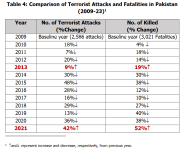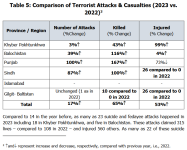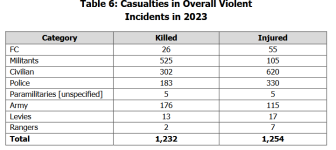RescueRanger
Moderator
- Sep 20, 2008
- 21,050
- 38,792
- Country of Origin

- Country of Residence

Overview
For the third year in a row, the number of terrorist attacks and consequent casualties posted an upsurge in 2023. A total of 306 terrorist attacks took place in Pakistan in the year – including 23 suicide bombings – which killed 693 people and injured 1,124 others. These attacks marked an increase of 17 percent from the year before, and the number of people killed in these attacks also represented an increase of 65 percent from those killed in similar attacks during
the previous year.
As many as 330 personnel of security forces and law enforcement agencies were martyred in the reported terrorist attacks in 2023 including 26 FC men, 176 policemen, 110 army officials, 11 Levies, five unspecified paramilitary soldiers, and two Rangers; another 518 personnel of security and law enforcement agencies were also injured. Similarly, 260 civilians lost their lives and another 559 were wounded in these attacks. Meanwhile 103 militants were killed and another 47 were injured, either in suicide blasts they perpetrated, or in security forces’ retaliatory fire following some attacks.
Religiously inspired militant groups such as the Tehreek-e-Taliban Pakistan (TTP), and other local Taliban groups including Tehrik-e-Jihad Pakistan (TJP) and Hafiz Gul Bahadur group, as well as Islamic State-Khorasan (IS-K), etc., perpetrated a combined total of 208 terrorist attacks – compared to 179 in previous year – which killed 579 people and injured 938 others.
Different Baloch and Sindhi nationalist insurgent groups carried out 86 attacks – as compared to 79 such attacks in 2022 – which claimed 90 lives and wounded another 151 people.
Meanwhile, compared to four in 2022, 12 sectarian-related terrorist attacks were recorded in 2023 that claimed 24 lives and inflicted injuries on another 35 people.

As in previous years, security and law enforcement personnel were the prime target of terrorist attacks in 2023. As many as 205 attacks in 2023, or about 67 percent of the total recorded attacks in the year, targeted personnel, vehicles, convoys, and posts or facilities of security and law enforcement agencies. Civilians were apparently hit in 19 attacks, while another 10 attacks targeted polio vaccination teams and their security escorts, mainly police. Meanwhile terrorists perpetrated nine attacks each against alleged spies/collaborators, and government officials/institutions/state symbols. Another nine attacks hit Sunni religious leaders and
community, and five terrorist attacks targeted members of Shia community.
Baloch insurgents also targeted non-Baloch workers and settlers in Balochistan in a total of five attacks. Other sporadic targets hit by the terrorists in 2023 are given at Table 1.
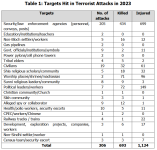
Besides perpetrating 23 suicide and fedayee attacks, the terrorists mainly used direct infantry fire in 160 attacks, improvised explosive devices or IEDs of multiple types in 65 attacks, and hand grenades in 38 attacks. The terrorists also used other attack tactics, though less frequently, including 12 coordinated gun-and-bomb attacks, three rocket attacks, three terrorist acts of sabotage and lynching, and one incident each of mortar attack and beheading.
About 93 percent of the total recorded terrorist attacks in Pakistan in 2023 concentrated in Khyber Pakhtunkhwa and Balochistan provinces.
As in the year before, Khyber Pakhtunkhwa faced the highest number of attacks for any one region of the country. PIPS recorded a total of 174 terrorist attacks in the province (or about 57 percent of the total attacks in Pakistan in 2023), which claimed 422 lives and injured 782 others. While the number of terrorist attacks posted only a slight increase of three percent from previous year, the number of people killed in these attacks in KP rose significantly by about 43 percent, and that of those injured by 99 percent. That suggests militants resorted to more intensified or high-impact attacks in the province during the year under review.
Secondly, most of the terrorist activity in Khyber Pakhtunkhwa was concentrated in two regions: one, southern KP districts; and second, the provincial capital and its neighboring Khyber district.
Indeed, over 82 percent of the total 174 attacks recorded in KP in 2023 concentrated in the six southern districts of the province (including North and South Waziristan, Bannu, Tank, Lakki Marwat and DI Khan) as well as the provincial capital Peshawar and neighboring Khyber district. Apart from these two regions, where mostly the TTP and other local Taliban groups remained active in the year 2023, a third KP region, i.e., Bajaur, also remained a flashpoint of terrorist violence that was mainly perpetrated by the Islamic State-Khorasan (IS-K) terrorist group. As many 10 attacks happened in Bajaur and most of these were claimed by the IS-K.
On the whole, terrorist attacks were recorded from 22 districts of the KP province in 2023.
Moreover, about 75 percent of the total reported attacks from Khyber Pakhtunkhwa targeted personnel of security and law enforcement agencies, mainly army and police. Balochistan was the second most terrorism-affected province in 2023, after Khyber Pakhtunkhwa. Baloch insurgent groups as well as religiously inspired militant groups perpetrated a total of 110 attacks in the province, compared to 79 in previous year. These attacks claimed 229 lives, compared to 106 in the year before, and wounded 282 others.
Different Baloch insurgent groups, mainly the Baloch Liberation Army (BLA) and Balochistan Liberation Front (BLF), perpetrated 78 attacks in Balochistan killing 86 people and wounding 137 others. The attacks by Baloch insurgent groups spread over 19 districts, mainly in central, southern and southwestern parts of the province, and largely targeted security forces.
Meanwhile, religiously inspired militant groups such as the TTP, Tehrik-e-Jihad Pakistan, and the Islamic State terrorist group (IS-K), etc., perpetrated 29 attacks in Balochistan, up from seven in previous year, which caused death to 139 people and injuries to another 144 people. While the TTP and affiliates perpetrated most of the attacks in northern, or largely Pashtun-populated districts of the province including those bordering on Afghanistan and KP, the IS-K was found more active in Mastung, Bolan and Kalat districts. Meanwhile, three sectarian- related attacks killed four and wounded one person in Balochistan in 2023.
Compared to eight in the previous year, 15 terrorist attacks took place in Sindh province including 14 attacks in Karachi alone, and one attack in Jamshoro in interior Sindh. These attacks killed a total of 16 people and injured 26 others. Seven of the reported attacks from Sindh in 2023 were perpetrated by sub-nationalist insurgent groups including four attacks by Sindhudesh Revolutionary Army (SRA) in Karachi and Jamshoro, and three by Baloch insurgent groups BLA and BLF in Karachi. Meanwhile, indicating a relative rise in sectarian violence, as many as seven sectarian-related terrorist attacks also took place in Karachi that claimed six
lives and injured two others. The banned TTP also perpetrated a gun-and-bomb coordinated attack on the Karachi Police Office martyring four people (3 attackers were also killed) and injuring 17 others.
Six terrorist attacks took place in Punjab in 2023, compared to five in the year before, which claimed 16 lives and injured eight others. Four of these attacks were perpetrated by the TTP and Tehrik-e-Jihad Pakistan, including three in Mianwali and one in Khanewal, which targeted law enforcement and intelligence officials. For one, security forces repulsed a major gun and bomb assault on the Mianwali Training Air Base of the Pakistan Air Force (PAF) in November by killing all nine attackers of TJP. Meanwhile, a Baloch insurgent group Baloch Nationalist Army (BNA) claimed one IED blast that targeted Jaffar Express near Chichawatni in Sahiwal district, killing a woman and injuring seven others. Separately, a member of Sikh community, Paramjit Singh Panjwar, was shot dead by unknown attackers in Lahore.
One, apparently, sectarian-related terrorist attack was recorded in Diamir (Gilgit-Baltistan), which claimed 10 lives and wounded 26 others.
(See Table 2)
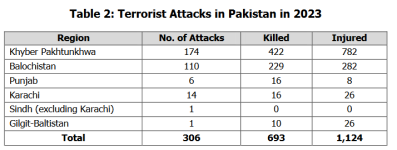
Comparison
Overall, 498 incidents of conflict-related violence of different types – as listed at Table 3 – were recorded in Pakistan in 2023. Apart from 306 terrorist attacks cited earlier, these violent incidents also included: security forces' 129 anti-militant operational or kinetic strikes and their 24 armed clashes/encounters with militants; a combined total of 12 cross-border attacks from Afghanistan, India and Iran; 10 incidents of communal/faith-based violence including mob attacks; seven (7) terror plots or bids; four (4) incidents of sectarian clashes; two incidents each of political/ethnic violence and inter-tribal clashes/attacks; one inter-militant clash/attack;
and one act of abduction. These overall incidents of violence killed a total of 1,232 people and injured 1,254 others.
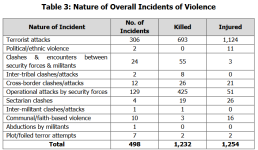
The number of overall incidents of conflict-related violence posted an increase of over 25 percent, from 398 in 2022 to 498 in 2023. As in the year before, the increase in overall violent incidents was mainly contributed by an upturn recorded in the number of terrorist attacks as well as counterterrorism operations. The overall number of people killed in these violent incidents also increased, by over 48 percent; from 832 in 2022 to 1,232 in 2023. (See Chart2)

As cited earlier, for the third year in a row the number of terrorist attacks in Pakistan posted an upsurge in the year 2023. This upsurge in terrorist violence in Pakistan also coincided with the Taliban's rise to power in the neighboring Afghanistan. Indeed, the year 2020 was the last year that had witnessed a relative decline in terrorist violence in Pakistan; that decline had been ongoing since 2014-15 following the military operations in ex-FATA, Karachi and an extensive counter-militancy campaign across the country including as part of National Action Plan. But from 2021-onward this declining trend did not sustain, and the incidence of terrorist
attacks took an upturn. (See Chart 3 and Table 4)
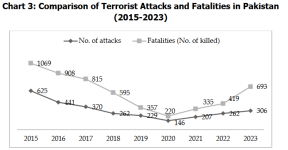
-- Cont Below--
For the third year in a row, the number of terrorist attacks and consequent casualties posted an upsurge in 2023. A total of 306 terrorist attacks took place in Pakistan in the year – including 23 suicide bombings – which killed 693 people and injured 1,124 others. These attacks marked an increase of 17 percent from the year before, and the number of people killed in these attacks also represented an increase of 65 percent from those killed in similar attacks during
the previous year.
As many as 330 personnel of security forces and law enforcement agencies were martyred in the reported terrorist attacks in 2023 including 26 FC men, 176 policemen, 110 army officials, 11 Levies, five unspecified paramilitary soldiers, and two Rangers; another 518 personnel of security and law enforcement agencies were also injured. Similarly, 260 civilians lost their lives and another 559 were wounded in these attacks. Meanwhile 103 militants were killed and another 47 were injured, either in suicide blasts they perpetrated, or in security forces’ retaliatory fire following some attacks.
Religiously inspired militant groups such as the Tehreek-e-Taliban Pakistan (TTP), and other local Taliban groups including Tehrik-e-Jihad Pakistan (TJP) and Hafiz Gul Bahadur group, as well as Islamic State-Khorasan (IS-K), etc., perpetrated a combined total of 208 terrorist attacks – compared to 179 in previous year – which killed 579 people and injured 938 others.
Different Baloch and Sindhi nationalist insurgent groups carried out 86 attacks – as compared to 79 such attacks in 2022 – which claimed 90 lives and wounded another 151 people.
Meanwhile, compared to four in 2022, 12 sectarian-related terrorist attacks were recorded in 2023 that claimed 24 lives and inflicted injuries on another 35 people.

As in previous years, security and law enforcement personnel were the prime target of terrorist attacks in 2023. As many as 205 attacks in 2023, or about 67 percent of the total recorded attacks in the year, targeted personnel, vehicles, convoys, and posts or facilities of security and law enforcement agencies. Civilians were apparently hit in 19 attacks, while another 10 attacks targeted polio vaccination teams and their security escorts, mainly police. Meanwhile terrorists perpetrated nine attacks each against alleged spies/collaborators, and government officials/institutions/state symbols. Another nine attacks hit Sunni religious leaders and
community, and five terrorist attacks targeted members of Shia community.
Baloch insurgents also targeted non-Baloch workers and settlers in Balochistan in a total of five attacks. Other sporadic targets hit by the terrorists in 2023 are given at Table 1.

Besides perpetrating 23 suicide and fedayee attacks, the terrorists mainly used direct infantry fire in 160 attacks, improvised explosive devices or IEDs of multiple types in 65 attacks, and hand grenades in 38 attacks. The terrorists also used other attack tactics, though less frequently, including 12 coordinated gun-and-bomb attacks, three rocket attacks, three terrorist acts of sabotage and lynching, and one incident each of mortar attack and beheading.
About 93 percent of the total recorded terrorist attacks in Pakistan in 2023 concentrated in Khyber Pakhtunkhwa and Balochistan provinces.
As in the year before, Khyber Pakhtunkhwa faced the highest number of attacks for any one region of the country. PIPS recorded a total of 174 terrorist attacks in the province (or about 57 percent of the total attacks in Pakistan in 2023), which claimed 422 lives and injured 782 others. While the number of terrorist attacks posted only a slight increase of three percent from previous year, the number of people killed in these attacks in KP rose significantly by about 43 percent, and that of those injured by 99 percent. That suggests militants resorted to more intensified or high-impact attacks in the province during the year under review.
Secondly, most of the terrorist activity in Khyber Pakhtunkhwa was concentrated in two regions: one, southern KP districts; and second, the provincial capital and its neighboring Khyber district.
Indeed, over 82 percent of the total 174 attacks recorded in KP in 2023 concentrated in the six southern districts of the province (including North and South Waziristan, Bannu, Tank, Lakki Marwat and DI Khan) as well as the provincial capital Peshawar and neighboring Khyber district. Apart from these two regions, where mostly the TTP and other local Taliban groups remained active in the year 2023, a third KP region, i.e., Bajaur, also remained a flashpoint of terrorist violence that was mainly perpetrated by the Islamic State-Khorasan (IS-K) terrorist group. As many 10 attacks happened in Bajaur and most of these were claimed by the IS-K.
On the whole, terrorist attacks were recorded from 22 districts of the KP province in 2023.
Moreover, about 75 percent of the total reported attacks from Khyber Pakhtunkhwa targeted personnel of security and law enforcement agencies, mainly army and police. Balochistan was the second most terrorism-affected province in 2023, after Khyber Pakhtunkhwa. Baloch insurgent groups as well as religiously inspired militant groups perpetrated a total of 110 attacks in the province, compared to 79 in previous year. These attacks claimed 229 lives, compared to 106 in the year before, and wounded 282 others.
Different Baloch insurgent groups, mainly the Baloch Liberation Army (BLA) and Balochistan Liberation Front (BLF), perpetrated 78 attacks in Balochistan killing 86 people and wounding 137 others. The attacks by Baloch insurgent groups spread over 19 districts, mainly in central, southern and southwestern parts of the province, and largely targeted security forces.
Meanwhile, religiously inspired militant groups such as the TTP, Tehrik-e-Jihad Pakistan, and the Islamic State terrorist group (IS-K), etc., perpetrated 29 attacks in Balochistan, up from seven in previous year, which caused death to 139 people and injuries to another 144 people. While the TTP and affiliates perpetrated most of the attacks in northern, or largely Pashtun-populated districts of the province including those bordering on Afghanistan and KP, the IS-K was found more active in Mastung, Bolan and Kalat districts. Meanwhile, three sectarian- related attacks killed four and wounded one person in Balochistan in 2023.
Compared to eight in the previous year, 15 terrorist attacks took place in Sindh province including 14 attacks in Karachi alone, and one attack in Jamshoro in interior Sindh. These attacks killed a total of 16 people and injured 26 others. Seven of the reported attacks from Sindh in 2023 were perpetrated by sub-nationalist insurgent groups including four attacks by Sindhudesh Revolutionary Army (SRA) in Karachi and Jamshoro, and three by Baloch insurgent groups BLA and BLF in Karachi. Meanwhile, indicating a relative rise in sectarian violence, as many as seven sectarian-related terrorist attacks also took place in Karachi that claimed six
lives and injured two others. The banned TTP also perpetrated a gun-and-bomb coordinated attack on the Karachi Police Office martyring four people (3 attackers were also killed) and injuring 17 others.
Six terrorist attacks took place in Punjab in 2023, compared to five in the year before, which claimed 16 lives and injured eight others. Four of these attacks were perpetrated by the TTP and Tehrik-e-Jihad Pakistan, including three in Mianwali and one in Khanewal, which targeted law enforcement and intelligence officials. For one, security forces repulsed a major gun and bomb assault on the Mianwali Training Air Base of the Pakistan Air Force (PAF) in November by killing all nine attackers of TJP. Meanwhile, a Baloch insurgent group Baloch Nationalist Army (BNA) claimed one IED blast that targeted Jaffar Express near Chichawatni in Sahiwal district, killing a woman and injuring seven others. Separately, a member of Sikh community, Paramjit Singh Panjwar, was shot dead by unknown attackers in Lahore.
One, apparently, sectarian-related terrorist attack was recorded in Diamir (Gilgit-Baltistan), which claimed 10 lives and wounded 26 others.
(See Table 2)

Comparison
Overall, 498 incidents of conflict-related violence of different types – as listed at Table 3 – were recorded in Pakistan in 2023. Apart from 306 terrorist attacks cited earlier, these violent incidents also included: security forces' 129 anti-militant operational or kinetic strikes and their 24 armed clashes/encounters with militants; a combined total of 12 cross-border attacks from Afghanistan, India and Iran; 10 incidents of communal/faith-based violence including mob attacks; seven (7) terror plots or bids; four (4) incidents of sectarian clashes; two incidents each of political/ethnic violence and inter-tribal clashes/attacks; one inter-militant clash/attack;
and one act of abduction. These overall incidents of violence killed a total of 1,232 people and injured 1,254 others.

The number of overall incidents of conflict-related violence posted an increase of over 25 percent, from 398 in 2022 to 498 in 2023. As in the year before, the increase in overall violent incidents was mainly contributed by an upturn recorded in the number of terrorist attacks as well as counterterrorism operations. The overall number of people killed in these violent incidents also increased, by over 48 percent; from 832 in 2022 to 1,232 in 2023. (See Chart2)

As cited earlier, for the third year in a row the number of terrorist attacks in Pakistan posted an upsurge in the year 2023. This upsurge in terrorist violence in Pakistan also coincided with the Taliban's rise to power in the neighboring Afghanistan. Indeed, the year 2020 was the last year that had witnessed a relative decline in terrorist violence in Pakistan; that decline had been ongoing since 2014-15 following the military operations in ex-FATA, Karachi and an extensive counter-militancy campaign across the country including as part of National Action Plan. But from 2021-onward this declining trend did not sustain, and the incidence of terrorist
attacks took an upturn. (See Chart 3 and Table 4)

-- Cont Below--

